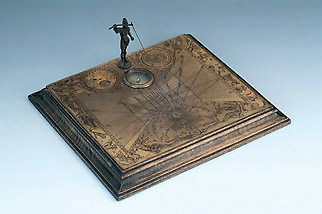
 |
| Catalogue |
 |
 Horizontal Dial There are also lines for solar declination, with a zodiac scale on either side, with symbols and representations of the signs, each divided 0 to 30 by 10, subdivided to 1, numbered by 10. The meridian line indicates the length of day and night by the numbers 9 to 16, marked ''QVANTITAS DIEI' and 'QVANTITAS NOCTIS'. There are also parallel lines for planetary hours, marked 2 to 10. To either side of the figure are two vovelles. One is a lunar volvelle and aspectarium, with a fixed scale of hours 0 to XII twice, divided to half and quarter hours, and a moveable disc with the diagram of planetary aspects, a circular aperture and a scale of hours 1 to 12 twice, subdivided to quarter and half hours. A small section of the edge of the disc at one 12 o'clock point is cut away to form an index and to reveal a scale of the age of the moon, 0 to 30, on the fixed plate beneath. The second volvelle is a form of astrological planetary table, indicating the planets ruling the hours of the day - the planetary hours - for the different days of the week. The days with their symbols are marked on the base plate as 'DIEIS LVNAE', 'DIEIS MERCVRI', etc. The moving disc has a spiral scale of planetary hours 1 to 12, marked 'NVMERVM HORARVM PLANETARVM', within which are seven personifications of the days or planets. The spare surface of the plate has elaborate decorative engraving, including animals, scrolls and foliage, and including allegorical representations of the sun and moon. Modern wooden base. Jim Bennett |



